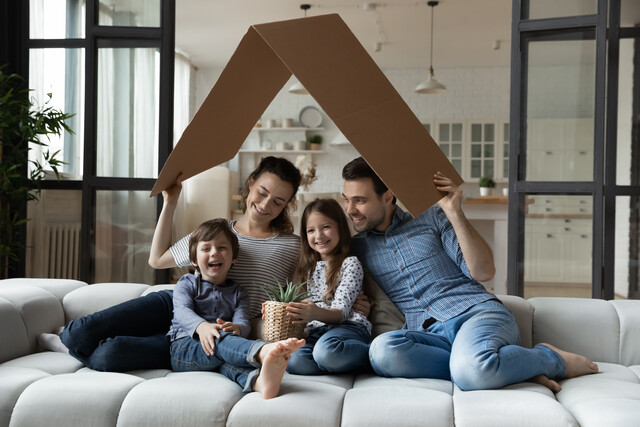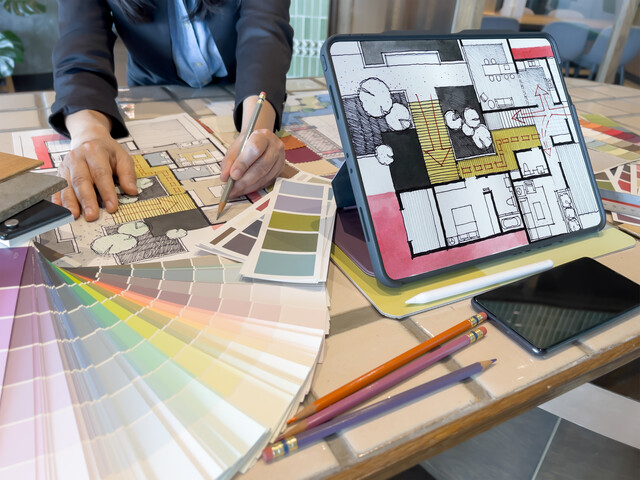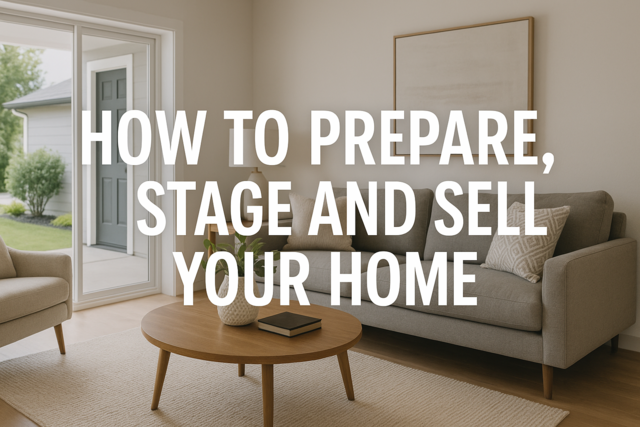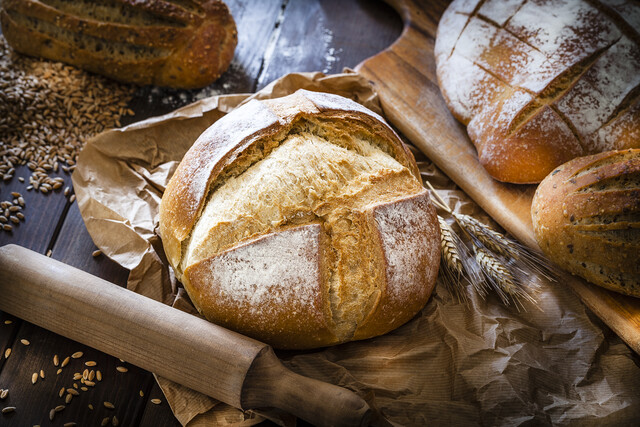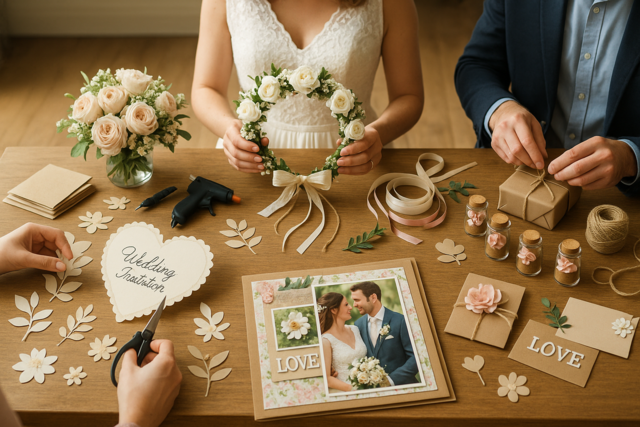INTRODUCTION
In recent years many more people have become environmentally aware, evident in bigger pushes for cleaner energy, more recycling programs, and efforts to increase sustainable farms. These social matters have inspired a sort of decor that celebrates a love and appreciation of nature and plants. Organic style features the idea of living in harmony with nature in a comfortable, fluid setting.
The look differs from heavily nature inspired Minimalist Japanese due to the Organic style's focus on greenery and fluid shapes rather than geometric shapes. The style focuses on natural materials, natural energy, recycling, and organic, fluid lines. The culminating result is a very light, airy room with plenty of greenery and movement.
Suitable for any and every room, particularly those with windows in consideration for the plant aspect of the style, Organic decor looks especially great in bathrooms, living areas, and bedrooms.
In this article you'll learn:
- Top color choices for achieving an Organic style
- Textures and fabrics most aligned with the decorating theme
- Finishing touches to consider utilizing
- Style lesson in decorating with plants
- Developing an Organic Tuscan style
COLORS
Think natural and organic when choosing a color palette: whites, browns and greens attain the look perfectly. Brighter whites work to contrast more with rich browns and greens, while ivories and oatmeals attain a more subtle look. Keep these contrast factors in mind when selecting colors attuned with underlying themes.
If using other colors as accents, keep them sparse as to not infuse too much drama into the room. Organic style doesn't benefit from too much drama- it's designed for laid-back style. Additionally, with such a strong emphasis on plants and nature, any drama should stem from the plant arrangements.
TEXTURES AND FABRICS
Natural, light weight and light toned fabrics are key. Cotton, linen, and muslin work well in white and neutral colors. With so much muted coloring the room will look bigger and showcase foliage better. However, if it looks too beige for your tastes, don't be afraid to add some rich blue in a rug or pillows for subtle color additions.
Other textural materials include rustic wood, a few iron elements, glass, and stone. Each additional element has the power to steer the main style towards an underlying theme:
- Rustic wood keeps Organic style natural, while sleek, clean wood adds a modern spin.
- A few iron elements add stability to the Organic style, with a surplus leaning towards a masculine theme.
- Glass elements help add surface area without taking up visual space. It works seamlessly in most Organic themes to boost the formality factor and visual appeal.
- Stone adds a cooler element in the Organic style scheme, with excess stone taking a road towards Greco-Roman or a Tuscan style.
Choose the amounts and placement of these textural elements with the Organic style and underlying themes in mind.
FURNITURE STYLES
Organic furniture should emit a sense of movement. It should feature fluid and smooth lines. Low-lying furniture tends to fit the scheme well. Don't be afraid to use simply crafted tables and chairs if organic style furniture is difficult to attain. Organic style is quite forgiving, and aims to be laid-back. Some great options include:
- Place a bed's boxspring on the ground for a lower bed set up. For a head board cover a large piece of plywood with some cotton stuffing covered with burlap or linen. Prop the board on the wall behind the mattress.
- A honey comb style shelf features curved planks of wood that come together and move apart every eight inches or so, resulting in an impressive giant honey comb look. Use it to hold books, photos, and trinkets.
- Create a living room sitting area with a low-lying, deep seated couch and rustic wood coffee table.
Organic furniture, being very fluid, can be difficult to replicate on non-organic pieces. Therefore mixing some already owned straight edged pieces with organic purchases can alleviate a huge budget deficit.
*LEARN MORE There are many organically designed furniture pieces with interesting, fluid lines. Research some designs created by bigger designers like Bae Sehwa, Joseph Walsh, and of course Ray and Charles Eames for inspiration.
FINISHING TOUCHES
The final look should be clean, natural, and showcase foliage. Therefore try to incorporate plenty of plants and natural materials into the finishing touches. In the next section we'll discuss in depth the concepts behind decorating with plants, so for now we'll focus on non-living additions. Here are some ideas:
- Fill bowls and vases with dried beans then insert candles for ambient light sources.
- Add burlap covered throw pillows for texture and a richer tone on a cream linen couch.
- Hang an arrangement of framed dried flowers, leaves, or a botanist's sketches.
- For seasonal additions consider adding vases of spring flowers, bowls of water for floating summer blossoms, arrangements of fall foliage, and garlands of fresh pine in the winter.
- Functional additions include a concealed compost bin and recycling separators in the kitchen.
- Frame a mirror with pieces of driftwood or branches from the woods.
- Choose low energy light bulbs to help save energy (and money on the electricity bill!)
- Spray paint some chicken wire black then mold it into a sculptural artwork piece, or a globe to put around a bare light bulb. Using it as a light shade adds interest without blocking any of the light.
- A string of lights along the ceiling or around some potted plants add playful ambient light. Camouflage the string by persuading a climbing plant to grow around it.
Keep extra items minimal and nature-centric with close attention to the volume of each textural element for balance. The spotlight should go towards plants and floral arrangements, which we'll discuss in depth next.
STYLE LESSON- DECORATING WITH PLANTS
Plants are the central focus of Organic style. Decorating with plants adds color and life into a design and is relatively easy to accomplish with beautiful results. The main factors with plant decor is considering the plants' needs in addition to aesthetics.
The most dramatic option, living walls, is a concept where the pots are installed into the wall, so once the plants reach maturity the wall is encompassed in greenery. It's beautiful and dramatic, but can be difficult to build properly. Worries include distributing weight evenly on the wall and avoiding mold growth, both of which can damage the wall.
An equally impressive option with less worries, is arranging a multitude of potted plants on tall glass shelves. The glass and its metal or wood frame should blend into the background, allowing for a dramatic green wall illusion.
Hanging terrariums also makes for an impressive focal point and makes use of otherwise empty space, perfect for smaller rooms. Be sure the screws holding the glass bowls are inserted correctly, and the rope or string is durable and tied tightly. Perfect plants for this set-up are air plants which actually don't require soil to grow in, need partial sunlight, and require occasional misting depending on the season. Very easy to care for plants arranged in an ascetically pleasing way is a win-win in design.
Once you've decided on the arrangements and chosen a prime location, it's time to evaluate how much sunlight reaches the area: full sun (6-8 hours), partial sun (3-4 hours), or indirect sun. At this time it's also ideal to honestly predict how much work you'll put into the plants: water every day, weekly, or hopefully monthly. A dramatic arrangement of plants loses its luster when half the plants are dried up from dehydration.
When these components are decided upon, select plants that fit into the area's sun range and your potential watering habits. Here are a few ideas to get your started:
- Full sun, lots of water: Look for tropical plants like hibiscus and consider English Ivy to climb across an indoor beam, but be sure to trim the vines occasionally.
-Partial sun, lots of water: Calathea produce lovely flowers, and although they live well in low light they tend to flower only in medium light; Anthurium produce rich colored flowers.
- Partial sun, minimal water: Snake plants are very easy going and grow impressive swordlike leaves; Pothos are easy to care for and provide plenty of greenery.
- Indirect sun, lots of water: Staghorn and other ferns thrive off humidity, so placing them in the bathroom is a no brainer.
- Indirect sun, minimal water: Aloe plants look great and can grow rapidly; Eternity plants (ZZ plants) are very forgiving and produce glossy leaves.
If you're worried about the sunlight variances for partial and low light plants, try moving the plants into light filled areas once a week or so for an hour or two. It'll ensure they get their fill of sun. Of course, follow any instructions included with the plant. Finally, factor in growth rate when placing potted plants as the perfect spot under a side table becomes imperfect when the plant grows to the tabletop.
Organic style truly thrives off a plethora of plant life. Not only do plants add beauty, but they filter the air so inhabitants will breathe easier. With these benefits in mind, feel free to add enough greenery to fill all the corners, it'll add a natural yet dramatic look that will be well worth the watering time.
SURPRISING FIT- ORGANIC TUSCAN STYLE
Organic style aims to embody easy going natural elements, while Tuscan style has a tendency to formalize natural elements. However, blending the two into an easy going yet somewhat formal style isn't too difficult.
Boost the stone elements, but try to keep large area tileswork, like on floors, a natural finish. Too much sheen can diminish the Organic style altogether. Be sure to add a rich colored area rug or natural fiber mat for additional texture and color.
Steer clear of too much obvious wine inspired decor, as typical with Tuscan style, but don't hesitate to add a few vineyard-inspired objects. Use a few empty bottles used to hold oversized palm leaves or long stemmed flowers, to bring both styles together well. Of course arrange a few potted plants, preferably in stone pots or wooden crates made from wine barrel wood.
Organic Tuscan style results in a more formal take of Organic style. It emphasize the natural elements typical to Tuscan style while elevating the laid-back nature of Organic style.
SUMMARY
For eco-conscious, laid-back individuals, the Organic styled room is an easy to live with design. It utilizes natural elements and fluid lines to create a comfortable and somewhat familiar space. The focus on plants and greenery makes it ideal for plant lovers and gardeners, yet low maintenance plants can complete the look just as well.
The color palette features muted colors, specifically whites, browns and greens. Choose the tones of whites based on underlying themes you'd like to achieve as brighter whites work to contrast more with rich browns and greens, while ivories and oatmeals attain a subtle look.
Natural fabrics and textures build the design. The familiar cotton, linen, and muslin work with burlap, natural fibers, and tweed to balance the sense of touch within an Organically styled room. Look for materials such as iron, rustic wood, and a bit of glass for furniture pieces. Depending on the underlying theme opt to increase one or two specific elements.
Polish off the room with plenty of greenery and elements not only inspired by nature, but gathered directly from nature. Be sure to place plants in prime sunlight conducive to their growth needs, and water as required. Play around with various arrangements, making greenery the dramatic focal points for the Organically styled room.
For a more formal take on the style, pair Organic with a Tuscan theme. Include rich reds and more stone elements as well as glossy finishes on the rustic wood to elevate the decor. The end result should be an elegant take on Organic style.
The laid-back, nature loving, fluid Organic style is suitable for all rooms and most lifestyles. Plants take centerstage in this design, easily creating beauty and drama, while fluid furniture makes moving around the room smooth. It's an ideal design for those looking for easy-going decor.
Key elements for achieving an Organic inspired style:
- Theme: Organic style features the idea of living in harmony with nature. The style focuses on natural materials, natural energy, recycling, and organic, fluid lines. The culminating result is a very light, airy room with plenty of greenery and fluidity.
- Color: Think natural and organic when choosing a color palette: whites, browns and greens attain the look perfectly. Brighter whites work to contrast more with rich browns and greens, while ivories and oatmeals attain a more subtle look.
- Textures and fabrics: Natural, light weight and light toned fabrics are key, preferably in cotton, linen, or muslin. For texture, incorporate natural fiber rugs, burlap, and even rough tweed. Other ideal textural materials include rustic wood, a few iron elements, glass, and stone.
- Furniture style: Organic furniture should emit a sense of movement, featuring fluid and smooth lines.
- Objects to pull it together: The final look should be clean, natural, and showcase foliage. Therefore try to incorporate plenty of plants and natural materials into the finishing touches to include dried beans, burlap, and rustic carved trinkets.
Words of caution:
- Don't let the prospect of purchasing all new fluid styled furniture deter you from this style. Simply purchase a few fluid pieces and pair them with simple, straight- lined furniture.
- When decorating with plants, keep in mind growth rates to avoid greenery unintentionally taking over a table.
- Keep finishing touches truly nature inspired or straight from nature to avoid straying from Organic towards another style.


